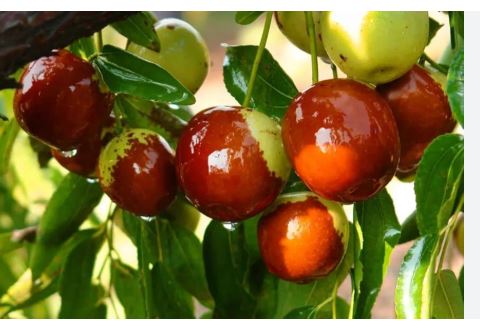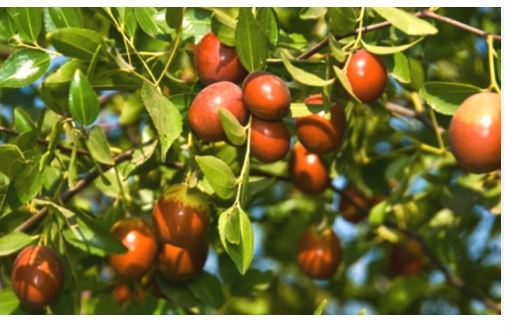
Jujube (Ziziphus jujuba) belongs to the Rhamnaceae family, or buckthorn family, within the genus Ziziphus. It’s a deciduous shrub or small tree, typically thorny, and classified as a drupe-producing species. The fruit contains a single hard pit, akin to olives or dates, and the plant is closely related to species like Ziziphus mauritiana (Indian jujube). It’s a dicot with simple, alternate leaves and small, yellowish flowers. The plant is known for its resilience and ability to tolerate drought and poor soil conditions.
Native to China, jujube has been cultivated for over 4,000 years, with records dating to the Zhou Dynasty (1046–256 BCE). Initially domesticated in the Yellow River Valley, it spread across Asia via the Silk Road, reaching the Middle East and Mediterranean by antiquity. Introduced to the U.S. in the 19th century, it gained traction in arid regions like California and Texas, evolving into numerous cultivars for food and medicine.
The fruit is small and oval, with smooth skin that changes from green to red or deep brown as it ripens. As the fruit reaches full maturity, it will also begin to wrinkle, resembling a dried date. Some varieties of Jujubes are considered edible in their yellow-green phase, and the skin may bear variegated hues of green, yellow, and brown depending on the degree of ripeness. Underneath the surface, the flesh is crisp, grainy, airy, and semi-aqueous with a snap-like quality similar to an apple. There is also a small, inedible pit found in the center of the pale green to white flesh. Jujubes vary in flavor from very sweet to a combination of sweet, tangy, and subtly tart.
The Jujube tree is also valued for its ornamental properties, as the weight of the fruit on the tree gives the branches an artistic, drooping appearance. In China, Jujubes were traditionally grown to maturity and consumed when they were wrinkled and dried, containing a date-like consistency.
Jujubes are nutrient-dense, offering vitamins C (up to 70-100 mg per 100 g fresh) and A, plus potassium, iron, and antioxidants like flavonoids. They’re low in calories (79 kcal per 100 g fresh) and high in fiber when dried. Traditionally used in Chinese medicine, they’re linked to benefits like improved sleep, digestion, and immune support due to bioactive compounds.
Jujubes are best suited for raw applications as their sweet and crisp nature is showcased when consumed fresh, out-of-hand. The skin and flesh are edible with the central pit discarded, and the fruits can be eaten as a crisp snack, infused into beverages, or sliced and mixed into green salads. In addition to fresh eating, Jujubes can be cooked into honey, jams, and syrups, made into a paste for fillings in cakes and pastries, candied, or incorporated into stews, porridges, and rice dishes.
Jujubes ripen from late summer to fall (August to November) in the Northern Hemisphere, with peak availability in September and October. Some cultivars, like Winter Delight, extend into early winter. Fresh jujubes are seasonal and perishable, while dried ones are available year-round, especially from major producers like China, Korea, and the U.S.

Types of Jujube
Li Jujube
- Description/Characteristics: One of the largest jujubes, round, about 1.5-2 inches in diameter; green when immature, turning mahogany when ripe; crisp, sweet, apple-like flesh with a single hard pit.
- Distribution: Originated in China; widely grown in the U.S. (California, Texas), China, and Korea; a top commercial variety globally.
- Culinary Uses: Eaten fresh as a snack, dried for a chewy treat, or used in teas and desserts like cakes and candies.
Lang Jujube
- Description/Characteristics: Pear-shaped, 1-2 inches long; thick, red-brown skin when ripe; sweet but less juicy than Li, with a firm texture; nearly thornless branches.
- Distribution: From China, prominent in Texas and California (U.S.), and across northern China; a classic drying variety.
- Culinary Uses: Best dried for a date-like consistency, used in soups, stews, or as a sweet snack; less common fresh.
Honey Jar Jujube
- Description/Characteristics: Small, round to oval, about 1 inch; bright green to reddish-brown; exceptionally sweet, juicy, and crunchy with a honeyed flavor.
- Distribution: Bred in the U.S. from Chinese stock; grown in California, New Mexico, and southern states; popular among home growers.
- Culinary Uses: Ideal fresh for snacking, added to fruit salads, or dried for a concentrated sweetness in trail mixes.
Sherwood Jujube
- Description/Characteristics: Medium-sized, elongated, 1-1.5 inches; dark red-brown when ripe; firm, sweet-tart flesh; late-ripening with a weeping tree shape.
- Distribution: Discovered in Louisiana (U.S.); cultivated in the U.S. Southwest, China, and parts of the Middle East.
- Culinary Uses: Eaten fresh or dried, used in preserves or jams, and pairs well with savory dishes like poultry.
Sugarcane Jujube
- Description/Characteristics: Small, oval, 1-1.5 inches; reddish-brown skin; very sweet, crisp flesh reminiscent of sugarcane; high sugar content.
- Distribution: Originated in China; grown in the U.S. (California, Florida), China, and Korea; favored for fresh eating.
- Culinary Uses: Consumed fresh, dried for candies, or brewed into a sweet tea; popular in Asian desserts.
Tigertooth Jujube
- Description/Characteristics: Medium, ovate, 1-1.5 inches; green to dark brown; dense, chewy flesh with a sweet-tart taste; named for its jagged stone.
- Distribution: From China; cultivated in the U.S. (Florida, California), northern China, and parts of Central Asia.
- Culinary Uses: Dried for a chewy snack, used in baking (e.g., breads), or fermented into jujube wine.
Shanxi Li Jujube
- Description/Characteristics: Large, round, up to 2 inches; reddish-brown when ripe; juicy, sweet, and slightly tangy; a premium Chinese variety.
- Distribution: Native to Shanxi Province, China; widely grown in northern China and exported globally.
- Culinary Uses: Eaten fresh, dried for teas (e.g., red date tea), or stuffed with nuts in Chinese cuisine.
Chico (GI-7-62) Jujube
- Description/Characteristics: Medium, round, 1-1.5 inches; mahogany skin; crisp, sweet flesh with a subtle tang; bred for early ripening.
- Distribution: Developed at USDA Chico Station (California); grown in the U.S. Southwest and parts of China.
- Culinary Uses: Fresh eating, dried for snacks, or used in sauces and compotes; versatile in recipes.
Ta-Jan (Big Date) Jujube
- Description/Characteristics: Oval, 1.5-2 inches; dark red-brown; sweet, juicy flesh with a mild flavor; slightly smaller than Lang.
- Distribution: From China; cultivated in Taiwan, China, and U.S. regions like California and Texas.
- Culinary Uses: Fresh or dried, used in soups (e.g., Korean samgyetang), or candied for sweets.
GA-866 Jujube
- Description/Characteristics: Medium, elongated, 1-1.5 inches; deep red when ripe; very sweet, crisp, and juicy; late-season fruit.
- Distribution: Bred in Georgia (U.S.); grown in the U.S. Southeast, California, and parts of China.
- Culinary Uses: Eaten fresh, dried for long storage, or added to baked goods like muffins.
Shui Men (Shuimen) Jujube
- Description/Characteristics: Large, elongated, up to 2 inches; reddish-brown; sweet, juicy flesh with a smooth texture; vigorous tree growth.
- Distribution: Originated in China; grown in northern China, California, and Texas; an early USDA import.
- Culinary Uses: Fresh or dried, used in Chinese medicinal teas, or preserved in honey syrup.
So (Dragon’s Claw) Jujube
- Description/Characteristics: Small to medium, round, 1-1.5 inches; dark brown; sweet-tart, crisp flesh; dwarf tree with zig-zag branches.
- Distribution: From China; grown in the U.S. (California, Florida), China, and Korea; ornamental appeal.
- Culinary Uses: Fresh eating, dried for snacks, or used in jujube vinegar and pickles (e.g., in Bengal).
Winter Delight Jujube
- Description/Characteristics: Medium, round, 1-1.5 inches; reddish-brown when ripe; sweet, juicy flesh with a crisp texture; ripens late in fall or winter.
- Distribution: Originated in China; grown in northern China, California, and Texas; prized for cold tolerance.
- Culinary Uses: Eaten fresh, dried for teas or snacks, or used in stews and soups for sweetness.
Mu Jujube
- Description/Characteristics: Small, oval, about 1 inch; dark red-brown; firm, sweet-tart flesh with a chewy bite; compact tree suited for small spaces.
- Distribution: From China; cultivated in China, Korea, and parts of the U.S. (California, Florida).
- Culinary Uses: Dried for a candy-like snack, used in baking (e.g., cookies), or brewed into herbal infusions.
Jin Jujube
- Description/Characteristics: Medium, pear-shaped, 1-2 inches; mahogany skin; sweet, juicy, and slightly tangy; high sugar content when dried.
- Distribution: Native to China’s Shandong Province; grown in China, Korea, and U.S. regions like California.
- Culinary Uses: Fresh or dried, used in Chinese red date tea, or candied for festive treats.
Globe Jujube
- Description/Characteristics: Large, round, up to 2 inches; reddish-brown; crisp, sweet flesh with a mild flavor; bred for uniform shape.
- Distribution: Developed in the U.S.; grown in California, Texas, and parts of China; a modern cultivar.
- Culinary Uses: Eaten fresh, dried for trail mixes, or sliced into salads for texture.
Sihong Jujube
- Description/Characteristics: Medium, elongated, 1-1.5 inches; dark brown; sweet, dense flesh with a subtle tartness; hardy tree.
- Distribution: From Jiangsu, China; widely grown in eastern China and exported as dried fruit.
- Culinary Uses: Dried for soups (e.g., chicken broth), used in porridge, or eaten as a chewy snack.
Contorted Jujube (Dragon Jujube)
- Description/Characteristics: Small, round, 1-1.5 inches; reddish-brown; sweet-tart, crisp flesh; named for its twisted, ornamental branches.
- Distribution: Originated in China; grown in the U.S. (California, Southeast), China, and Japan.
- Culinary Uses: Fresh eating, dried for snacks, or pickled; also valued as a garden plant.
Autumn Beauty Jujube
- Description/Characteristics: Medium, oval, 1-1.5 inches; deep red when ripe; sweet, juicy, and slightly nutty; late-season ripening.
- Distribution: Bred in the U.S.; cultivated in California, Texas, and parts of China; a newer variety.
- Culinary Uses: Fresh or dried, used in jams, or added to baked goods like scones.
Silverhill Jujube
- Description/Characteristics: Medium, elongated, 1-2 inches; dark red-brown; very sweet, crisp flesh; drought-tolerant and productive.
- Distribution: Originated in Alabama (U.S.); grown in the U.S. Southeast, California, and China.
- Culinary Uses: Eaten fresh, dried for long storage, or used in fruit leathers and desserts.
Bok Jo Jujube
- Description/Characteristics: Medium, round, 1-1.5 inches; reddish-brown; sweet, juicy flesh with a floral hint; popular in Korea.
- Distribution: From Korea; grown in South Korea, China, and U.S. regions like California.
- Culinary Uses: Dried for Korean teas (daechu-cha), used in samgyetang (ginseng chicken soup), or candied.
Redlands Jujube
- Description/Characteristics: Large, oval, 1.5-2 inches; dark mahogany; sweet, crisp flesh with a balanced flavor; high-yielding.
- Distribution: Developed in California (Redlands); grown in the U.S. Southwest and parts of China.
- Culinary Uses: Fresh eating, dried for snacks, or processed into jujube butter or syrup.
Ya Tsao Jujube
- Description/Characteristics: Small, round, 1-1.5 inches; red-brown; sweet-tart, juicy flesh; early-ripening with a bushy tree.
- Distribution: From Taiwan; grown in Taiwan, southern China, and U.S. states like Florida and California.
- Culinary Uses: Fresh or dried, used in Taiwanese herbal teas, or preserved in syrup.
Black Sea Jujube
- Description/Characteristics: Medium, oval, 1-1.5 inches; nearly black when ripe; sweet, dense flesh with a rich, earthy taste; cold-hardy.
- Distribution: Originated near the Black Sea (possibly Georgia or Turkey); grown in Central Asia, China, and U.S.
- Culinary Uses: Dried for snacks, used in compotes, or fermented into a traditional jujube liquor.